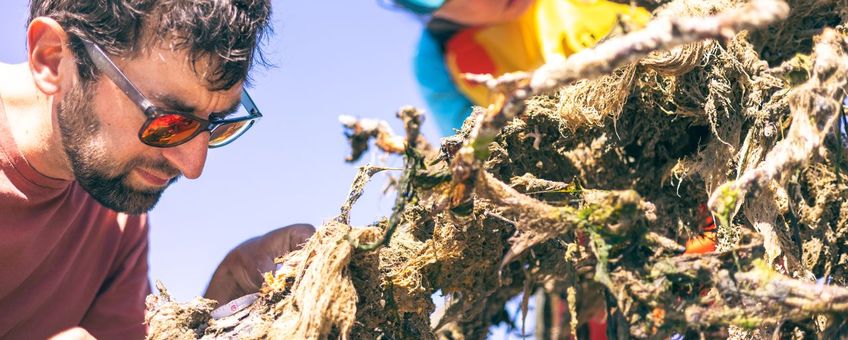
Pear trees teeming with fish and other sea life
NIOZ Royal Netherlands Institute for Sea ResearchReplacing driftwood
The experimental, artificial reefs are in part a replacement for driftwood that used to end up in the sea in earlier times. "Before people controlled the rivers with dams and dikes, they carried a lot of trees out to sea. After six months to more than a year, some of those trees sank to the bottom. There they provided structure on and in the soil," Dickson said. "You hardly see that natural driftwood anymore in Europe. With these artificial ‘tree reefs’, we may also be able to kickstart the restoration of the vast mussel and oyster reefs that used to occur on the bottom of the Wadden sea and North Sea. Due to fishing, dredging, trawling and disease, many of those reefs, and with them the natural structure they provided, have disappeared."
 Six pear trees make three cubic metres pyramid-shaped reef (Source: NIOZ)
Six pear trees make three cubic metres pyramid-shaped reef (Source: NIOZ)
Pragmatic idea
Using pear trees as an alternative reef, was a pragmatic idea of NIOZ researcher Tjeerd Bouma, says Dickson. "On a bicycle tour through the Dutch orchards, he saw how many of these trees have become obsolete at the end of their economic life. This makes them a cheap source of wood, which is available in large quantities. Every year, about 400 hectares of fruit trees are uprooted in the Netherlands."
Monitoring life
With blocks of concrete at their base, 192 trees, made into 32 individual reefs were placed into the Wadden Sea in 2022. Using cameras on the concrete weights, along with fyke-style fishing nets, and also by briefly bringing up some of those reefs at regular intervals, Dickson and colleagues monitor how much life they attract. "And that's enormous," he saw. “The reefs are hosting five times the number of fish compared to nearby sand flats, and three times as many species!”
 Seventy or so cuttlefish eggs on pear tree (Source: NIOZ)
Seventy or so cuttlefish eggs on pear tree (Source: NIOZ)
Predatory fish
"When we brought up the first reefs after four months, one of the things we saw was a lot of tunicates growing on the wood. Now, after 16 months, many of the small and medium-sized individuals have been eaten by 'something.' The remaining ones have grown very large. Whatever that “something” is, we cannot yet say, but we believe it to be larger predatory fish.”
Fishing vessel
"When we briefly lifted the reefs onto the deck of the fishing vessel TX96 after 16 months we also saw large numbers of Pholis gunnellus coming out from between the branches. There were also literally thousands of cuttlefish eggs in a single reef. These artificial reefs have become obvious breeding grounds for fish as well as settlement sites for 'sessile animals', such as the tunicates, barnacles, anemone, and seaweeds.”
 Jon Dickson with pear tree reef after 16 months in Wadden Sea (Source: NIOZ)
Jon Dickson with pear tree reef after 16 months in Wadden Sea (Source: NIOZ)
Replaced by nature
The ‘pear reefs’ will disappear on their own over time. "Already we can see that woodworms have affected the wood. But if things go well, after a few decades the trees will be so full of reef building organisms, like shellfish, that a natural reef may be left behind," Dickson hopes.
Mitigate
The researcher is very excited about the rapid results being achieved with these artificial reefs. "To find such relative biodiversity in fish communities on the reefs in so short a time is encouraging to see. It shows we can potentially mitigate some of the ongoing biodiversity loss with active restoration efforts. With pear trees so abundantly available, it is even possible to upscale these experiments to large areas in the North Sea and even to the ocean floor, where natural structures are lost as well."
 Measuring percentage life cover within 10x10 centimetre transect sections (Source: NIOZ)
Measuring percentage life cover within 10x10 centimetre transect sections (Source: NIOZ)
Text and photos: NIOZ (lead photo: Jon Dickson and Dorien Luttikhuis with tree reefs)
